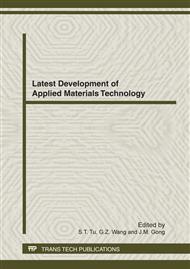p.16
p.22
p.28
p.36
p.40
p.46
p.51
p.56
p.64
Dynamic Tensile Characteristics of DP600 Steel Sheets for Automotive Applications
Abstract:
To reduce fuel consumption and greenhouse gas emission, dual phase (DP) steels have been considered for automotive applications due to their higher tensile strength, better initial work hardening along with larger elongation compared to conventional grade of steels. In such applications, which would create potential safety and reliability issues under dynamic loading, the mechanical behavior of DP steel considering the strain rate must be examined. In the present study, the dynamic tensile behavior of DP600 steel sheets was investigated using a high-speed tensile testing machine at various strain rates. And the quasi-static tensile testing was also conducted on the steel to understand the effect of the strain rate on the tensile property. The fracture mechanisms of the steel were also analyzed. The results show that the mechanical properties of DP600 steel are noticeably influenced by the strain rates. As the strain rate increases, the strength of the steel increases and the obvious yield phenomenon can be observed when the strain rate is above 0.01 s-1. The fracture elongation of DP600 steels decreases with increasing strain rate from 0.001 to 1 s-1, then increases up to the strain rate of 100 s-1 and reaches the lowest value at the strain rate of 1000 s-1. DP600 steel sheet exhibit typical ductile fracture characteristics with dimples morphology of the facture surface when tensile deformed at various strain rates.
Info:
Periodical:
Pages:
40-45
Citation:
Online since:
April 2012
Authors:
Keywords:
Price:
Сopyright:
© 2012 Trans Tech Publications Ltd. All Rights Reserved
Share:
Citation:


